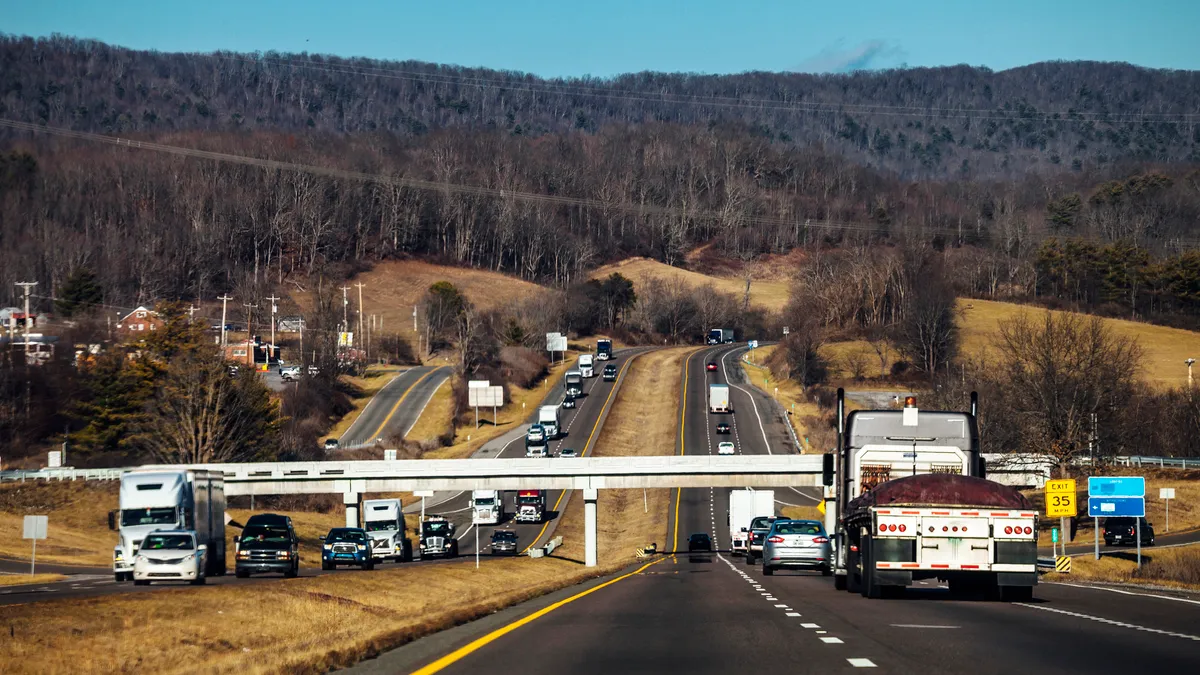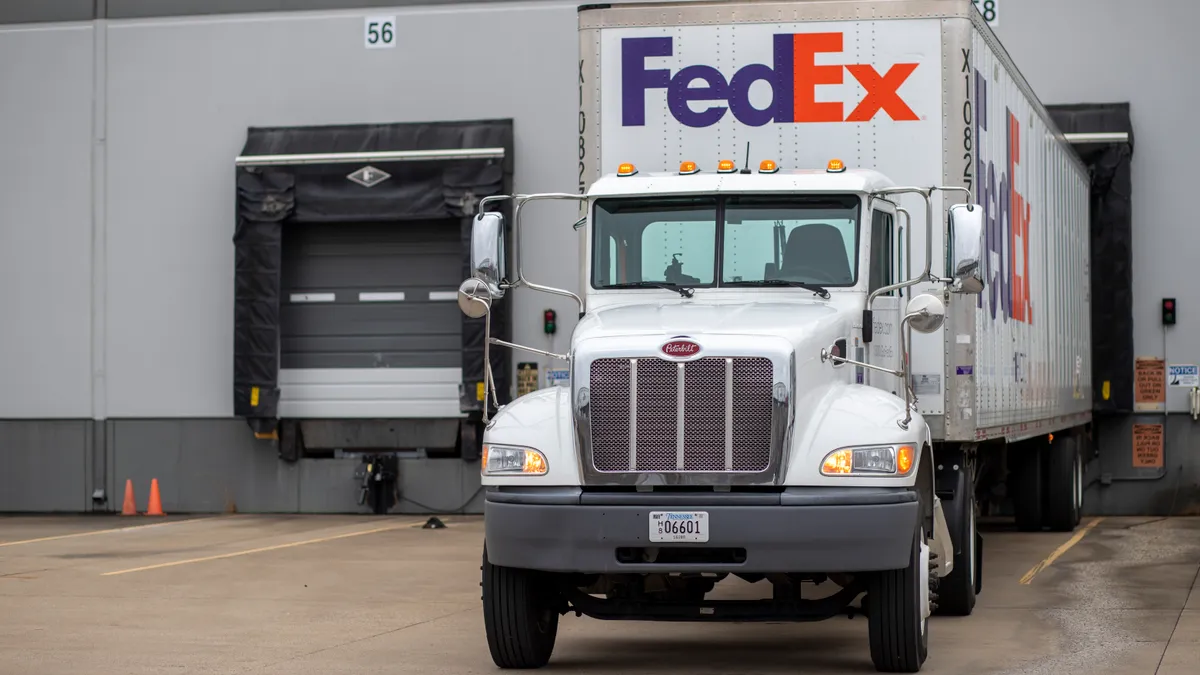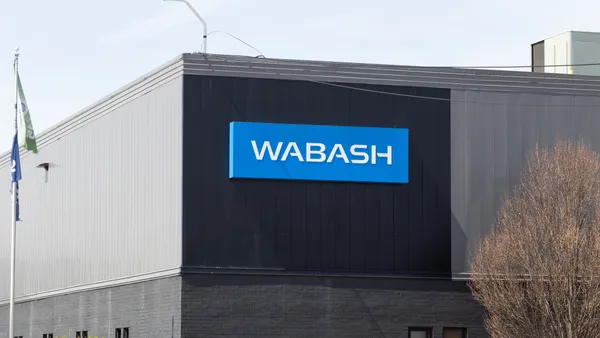Operational cost increases, technology adoption and labor retention will have the attention of trucking executives in 2024 as they await a rebound in freight demand.
Many will welcome new workers, trucks, terminals and customers as carriers continue to vie for market share following the largest bankruptcy in trucking history, at Yellow Corp., last summer.
Industry interests will push to frame federal fuel excise tax repeal, permanent truck parking funding and brokerage fraud protections as low-hanging, bipartisan fruit in a presidential election year.
All these trends will be on Webb Estes’ mind after an eventful first year at the helm of Estes Express Lines as president and COO.
The carrier bought two dozen Yellow terminals and gave record raises to its workforce in the middle of last fall's cyberattack. This month, it added 12 electric Freightliner eCascadias in California it ordered in 2019 and installed solar panels at multiple terminals.
Witnessing 22,000 Estes employees jump to action after the cyberattack drove home the main lesson the company president will carry with him into his second year — and for the rest of his career.
“I have awesome people that care passionately about doing a good job,” Estes said. “It takes all of us.”
Keeping a close eye on rising costs
Average marginal trucking costs reached a record $2.25 a mile in 2022, according to the American Transportation Research Institute. The costs of operating remained elevated last year, and they’re unlikely to fall much, if at all, this year.
It’s one reason the American Trucking Associations will continue making the case to repeal the federal fuel excise tax, which would save carriers about $25,000 per tractor while spurring the adoption of newer, cleaner trucks, according to the group.
“That amount of money makes a big difference in how a business succeeds or fails,” American Trucking Associations President and CEO Chris Spear said in an interview. “I'm optimistic that this would make a significant difference in every member's operational costs.”
Trucking operational costs reached record high in 2022
As they await a freight rebound, carriers will likely continue closely monitoring fuel, labor, lease payments, maintenance and other costs — zeroing in on any potential savings.
“Truckers are dying out there right now,” Owner-Operator Independent Drivers Association EVP Lewie Pugh said in an interview.
Focusing on retention amid labor unrest
While sinking freight demand took the edge off complaints about a driver shortage, and some firms reduced headcount to align their businesses with lower revenues, labor requires the consistent focus of trucking executives, regardless of the market.
If the trucking industry sought to avoid work stoppages like those that roiled automakers’ operations last year, 2024 is already a disappointment. More than 130 US Foods truck drivers in the Chicago area went on strike in the second week of January, saying the company had failed to meet its demands in negotiations.
The Teamsters union lost over 22,000 members when Yellow folded. But in a year of union activism across the U.S., the Teamsters negotiated contracts with TForce Freight and ABF Freight, securing labor contracts last year for members at both remaining major unionized LTL carriers. A 39-day strike by United Auto Workers at Mack Trucks led to a new five-year contract for nearly 4,000 workers.
If contract negotiations are any indication, pay raises are far from workers’ only concern. They also want protections from job automation and limitations on how employers use tools like driver-facing cameras.
The TForce Freight contract prohibits discipline from cameras and the use of robots, driverless vehicles, drones or other technology to move freight or replace drivers, clerks or dockworkers. ABF Freight’s contract also bans the use of inward-facing cameras, audio recorders, body and biometric sensors or driverless autonomous vehicles.
Absorbing Yellow’s bombshell bankruptcy
Yellow’s freight might’ve been the least valuable of its assets for competitors to pounce on as the once-largest unionized LTL carrier spiraled into Chapter 11 bankruptcy last summer.
The carrier’s roughly 170 owned trucking terminals — many in high-demand markets — collected nearly $2 billion from the top bidders at auction. A federal court overseeing the bankruptcy case approved a plan for auctioneers to sell its trucks and trailers this year.
Yellow’s demise buoyed Yellow’s LTL competitors in the second half of last year by removing capacity from the market, said Frank Granieri, COO of supply chain solutions at A. Duie Pyle. His company acquired four Yellow terminals in the auction.
“It's interesting, if not for Yellow going out [of business], if you look at the weight per shipment across the industry, you can see that it's pretty soft,” Granieri said in an interview. “That's indicative of a soft economy, particularly from the manufacturing side and housing, etc.”
Adopting EV trucks and other technology
The trucking industry has no shortage of those who remain wary, at best, of heavier, costlier electric-powered trucks and other emerging technologies.
But companies’ sustainability policies and regulatory deadlines requiring shifts to zero-emission vehicles in California and elsewhere have prompted fleets to increasingly add batches of Freightliner eCascadias and other EV trucks.
Estes, Walmart Canada, Reyes Coca-Cola Bottling, Penske Truck Leasing, Pitt Ohio and Ryder System are among the growing list of companies who have ordered or received deliveries of zero-emissions trucks in the past few months alone.
The ransomware attack at Estes reminded carriers of the technology investments necessary to protect their operations. The National Motor Freight Traffic Association advised the industry to prepare for threats by upgrading systems and training employees to recognize phishing in its 2024 Trucking Cybersecurity Trends Report.
“With all the necessary attention of enterprise systems and the technology that supports them, we cannot overlook threats aimed directly at the trucks themselves,” the report said.
Pushing for parking and an end to brokerage fraud
OOIDA’s Pugh hoped 2023 would be the year the federal government would pass legislation allocating hundreds of millions of dollars for truck parking.
It wasn’t. But OOIDA plans to redouble the push in a critical election year.
“It didn’t pass [in 2023], 100%, in my opinion, because of all the political infighting,” Pugh said. Its appeal in an election year? “Not only can lawmakers point at it, but so can our president. ... He needs something to point to.”
More truck parking and a crackdown on rampant brokerage fraud — inflicting the industry with an estimated $800 million in unnecessary expenses and costing drivers countless hours and miles of driving without payment — are priorities OOIDA will advocate for this year
“America needs these things to pass to move forward, to be a better, stronger country and take care of its citizens,” Pugh said.






















